Physical Address
304 North Cardinal St.
Dorchester Center, MA 02124
Trauma is the most common cause of death and a significant cause of morbidity in children. Both accidental and nonaccidental trauma are common in children.
Several anatomic differences in younger children should be highlighted to understand why younger children are more susceptible to certain types of injury. First, the skull of young children is thin and pliable and thickens during the first 2 years of life. Second, a skull with fused sutures transfers the force of an impact throughout the skull and is more prone to fracture compared to a skull with unfused sutures. Third, an infant’s head weighs about 10% to 15% of the total body weight compared to only 2% to 3% in an adult. Fourth, the infant brain has a softer consistency because of higher water content, immature glial cells, immature myelination, and smaller axons. Consequently, the unmyelinated brain has a lower threshold for injury than an adult. Last, the neck muscles of a child are less developed and provide less protection from acceleration-deceleration trauma.
Accidental head trauma includes injuries from birth trauma, motor vehicle accidents, drowning, crush injury, and falls. Short falls that occur in and around the home from a distance of less than 6 feet are associated with focal contact injuries such as scalp contusion or laceration. About 1% to 3% of short falls in young children cause a skull fracture. The majority of these skull fractures are simple linear fractures without associated intracranial hemorrhage or neurologic deficit.The minority of fractures are associated with an epidural hemorrhage or, less commonly, a subdural hemorrhage. With short falls there is no diffuse brain injury, however falls from heights greater than 10 feet, such as those from a building, lead to greater head injury and are similar to crush injuries. Crushing head injury is relatively common in children compared to adults. Examples of crush injuries include heavy objects, such as a television falling onto the head. Crush injuries cause parenchymal contusions, lacerations, and fractures.
Epidural hemorrhages require an impact to the head and are associated with skull fractures in 85% of cases. Epidural hemorrhages usually occur from falls in young children, rather than an inflicted blow to the head, which is more likely to cause acceleration of the head and more diffuse injury. Clinical significance of an epidural hemorrhage depends on the size and rate of enlargement.
Subdural hemorrhages can result from both impact injuries as well as from inertial forces. The most common cause of subdural hemorrhage in young children is abusive head injury.
Parenchymal contusions are commonly seen adjacent to a skull fracture. However, coup and countercoup contusions are rare in children less than 4 years of age because of the soft consistency of young brains. Because a young child is already near the ground, a fall does not accelerate the head sufficiently to cause a countercoup contusion.
Abusive head trauma (AHT) accounts for the majority of head injury in children less than 1 year, and head injury is the leading cause of death from child abuse. A multidisciplinary approach is necessary as the diagnosis involves clinical history, physical examination, laboratory results, radiological findings, and scene investigation and interviews with other family members by child protective services and police. AHT has a multitude of possible imaging findings, which are demonstrated in this chapter.
Head trauma findings seen on imaging include soft tissue contusions, lacerations, fracture, epidural hemorrhage, subdural hemorrhage, subarachnoid hemorrhage, parenchymal contusion, parenchymal laceration, axonal injury, edema, and ischemia. Radiographs, ultrasound, CT, and MRI are imaging modalities commonly used to evaluate pediatric trauma patients. Radiographs are quick and useful for determination of fractures but have become less commonly used in the acute trauma patient. CT imaging is often the initial neuroimaging study performed for assessment of head trauma due to the fast acquisition, and excellent detection of fractures and intracranial hemorrhage. MRI is more sensitive than CT for extent of intracranial trauma, particularly diffuse axonal injury and ischemia but has longer acquisition time compared to CT and may require sedation so CT is currently the initial imaging study of choice. This section illustrates the imaging findings of head trauma and related diagnoses in children seen on radiographs, ultrasound, CT, and MRI.
Serosanguinous, transudative fluid between the skin and galea aponeurosis typically located at the vertex that occurs during normal birth.
Crosses sutures.
Secondary to high pressure on the infant’s head during labor. Typically seen in primigravidas, prolonged deliveries, and premature rupture of membranes (due to reduced amniotic fluid).
Typically diffuses quickly and becomes stable or rapidly resolves within 24 to 48 hours. Consequently, treatment is rarely necessary.
Imaging may be performed to exclude subgaleal hematoma (SGH).
Many small emissary veins traverse the loose connective tissue of the subgaleal space. A tear or tears of these emissary veins is believed to be the cause of an SGH.
External force such as use of vacuum extraction (associated with SGH in 60% to 89% of cases) can result in rupture of veins in the subgaleal space and subsequent hemorrhage that crosses the sutures.
A SGH can result in significant blood loss. A 1-cm increase in depth of the subgaleal space can contain 40 to 260 mL of blood. The circulating blood volume in a neonate is approximately 90 mL/kg body weight such that in a 3-kg neonate, a blood loss of 54 mL is a 20% loss of circulating blood volume.
Signs and symptoms: Boggy head with pitting edema, increasing head circumference, jaundice, eye and ear swelling. A drop in hemoglobin is a late sign of severe hemorrhage because of insufficient time for fluid shift to cause the hemodilution.
Severity criteria: Approximately 6% are asymptomatic, 15% to 20% are mild (<1-cm increase in head circumference, no jaundice, no hypovolemia), 40% to 50% are moderate (1–3 cm increase in head circumference, jaundice, mild hypovolemia), and 25% to 33% are severe (>3 cm increase in head circumference, jaundice, severe hypovolemia).
Hypoxic ischemic injury occurs in 62% to 72% of subgaleal hematomas, and brain trauma (edema or hemorrhage) occurs in 33% to 40%.
Localized hemorrhage between bone and periosteum
More common in primigravidas, fetal macrocephaly, instrument-assisted delivery, prolonged and/or difficult labor, premature rupture of membranes, and with oligohydramnios (can occur in utero)
Aspiration is not performed because typically the blood has clotted and there is risk for causing infection
Hemorrhage can take weeks to months to resorb and can calcify to result in skull asymmetry
Associated skull fracture in 5% to 18%
Does not cross sutures and not a risk for serious blood loss due to the containment
Unilateral or bilateral
May coexist with subgaleal hematoma and caput succedaneum
Calcification may occur in 3% to 5% of subperiosteal hematomas. Calcified subperiosteal hematomas have been subclassified as type 1 (nondepressed inner cortex) and type 2 (depressed inner cortex)
Occurs in approximately 50% births
No intervention or follow-up imaging in vast majority
Usually small (<4 mm in thickness)
T1W hyperintense signal on MRI and hyperdense on CT
No significant mass effect, and located posterior fossa, tentorium, posterior falx, posterior occipital (<4 mm in thickness)
Most resolve by 1 month. All resolve by approximately3 months
In addition to subdural hemorrhage (SDH), can also see small amounts of subarachnoid hemorrhage (SAH) and intraventricular hemorrhage (IVH) from birth trauma
Hyperdense dural sinuses can be seen on head CTs of neonates and accentuated by the relative lower density of the immature brain. Differentiation from thrombus can be difficult and result in potential pitfall.
Mean Hounsfield units (HU) demonstrate a correlation with hemoglobin levels (correlation coefficient r = 0.411). The mean sinus density in normal pediatric population is 44 to 47 HU.
Thrombosed venous sinuses measured 66 HU; however, the neonatal population has not been adequately studied.
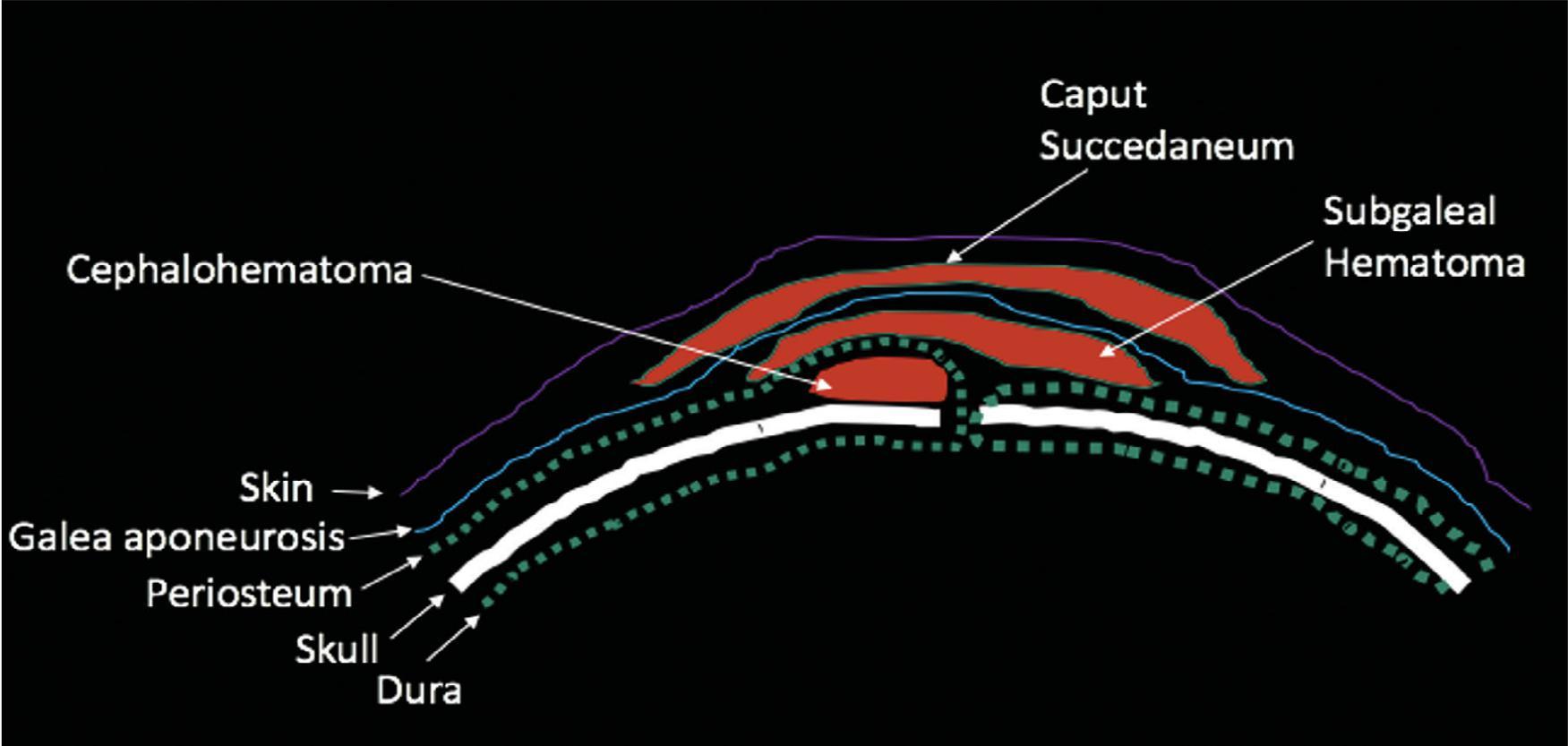
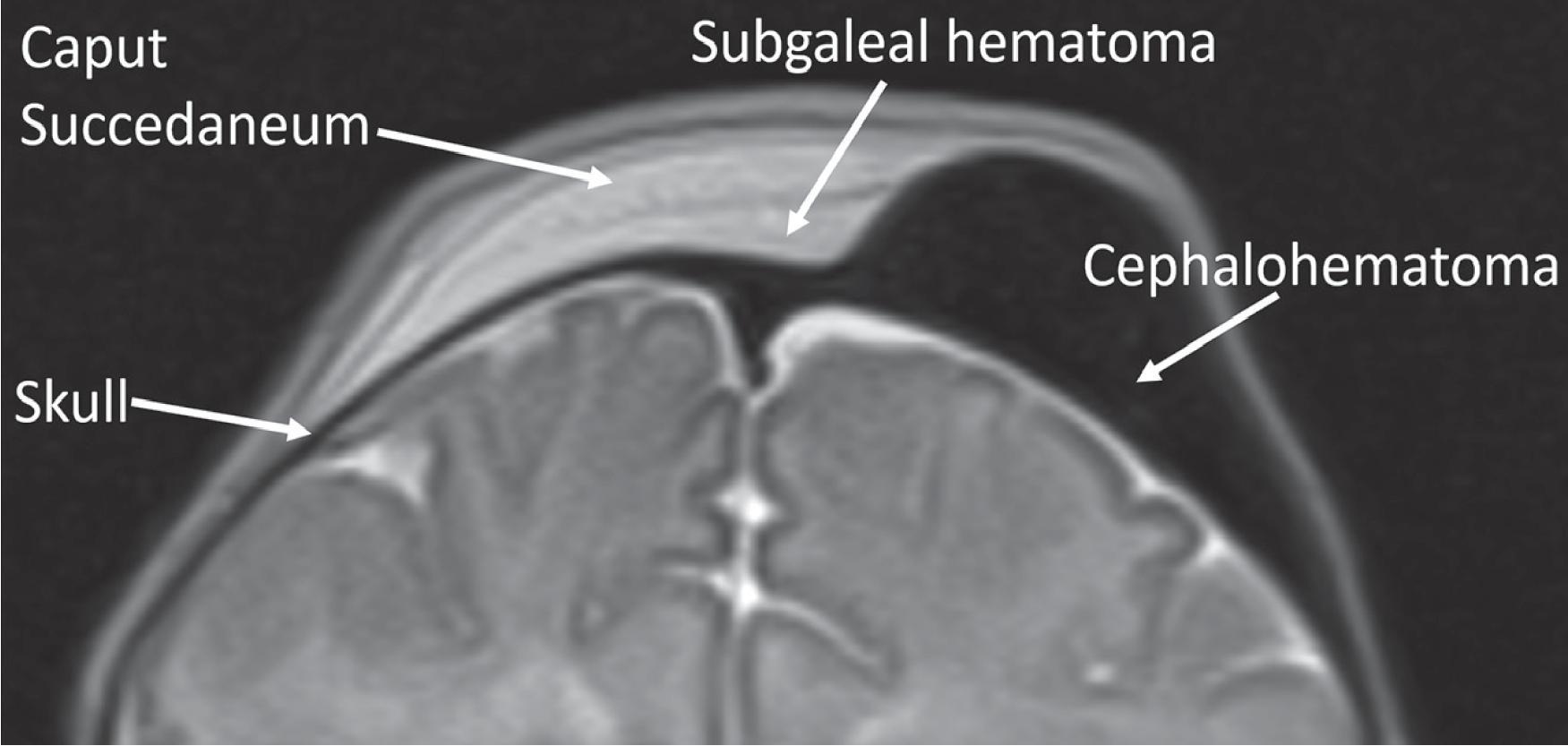


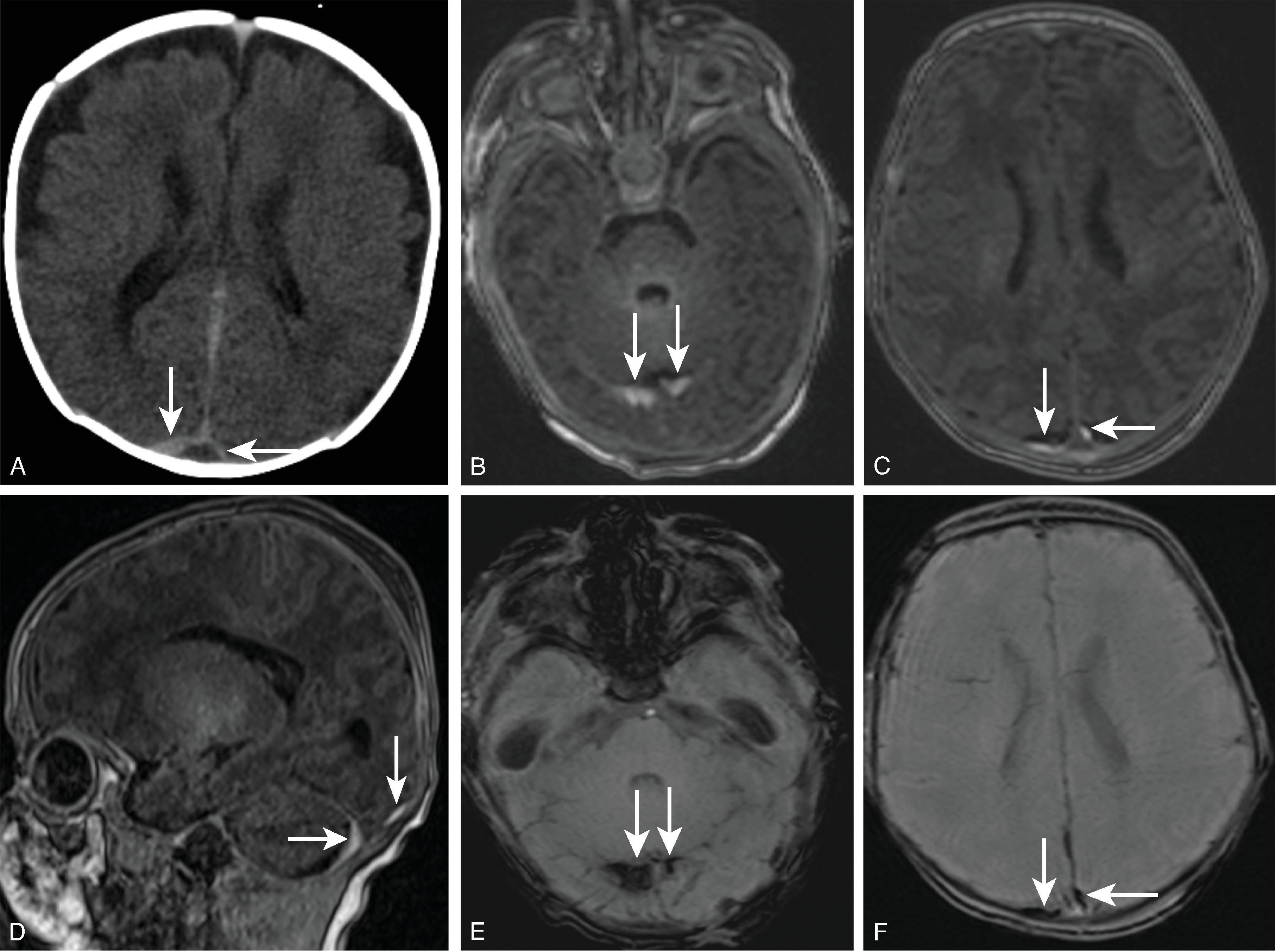
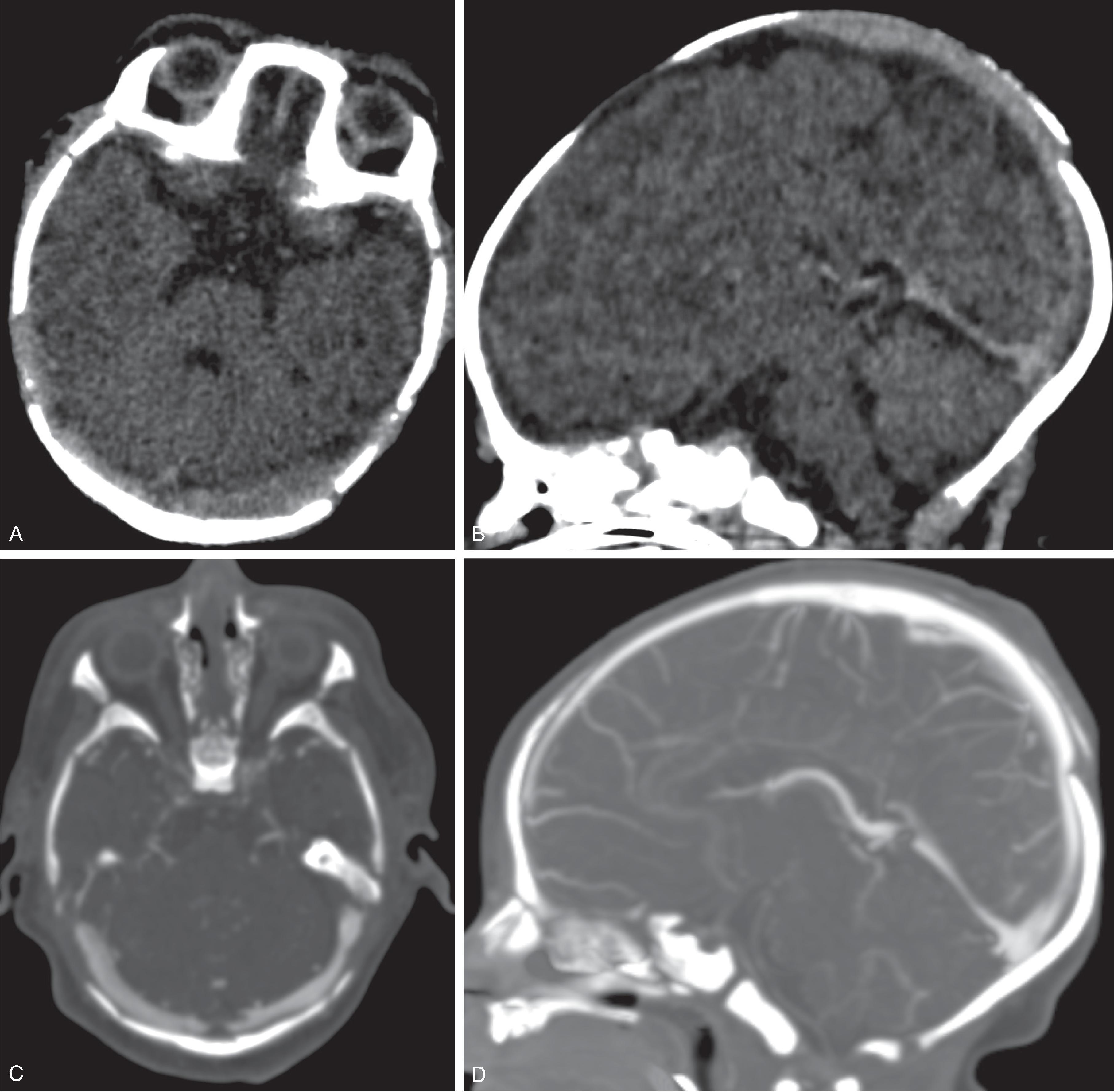
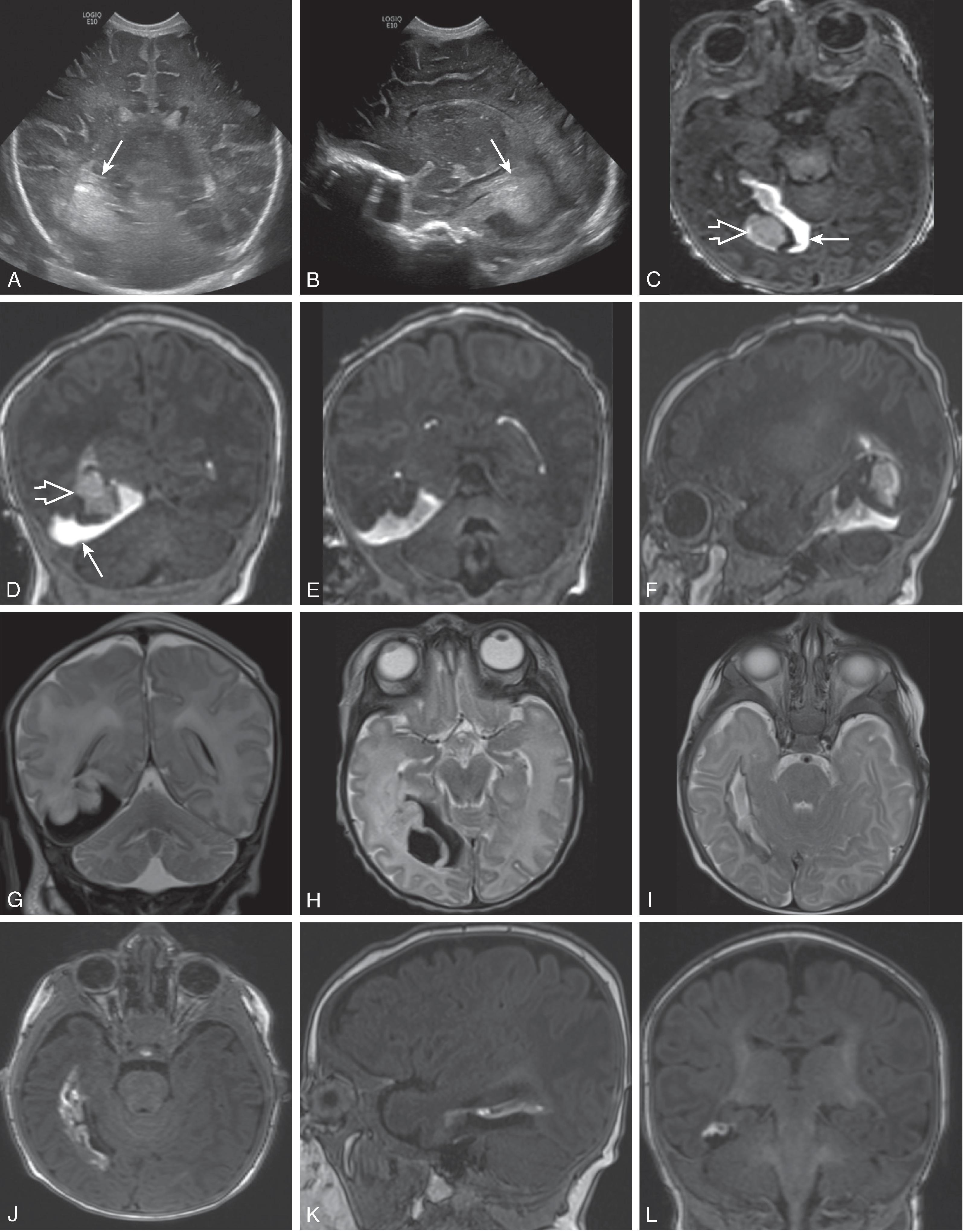
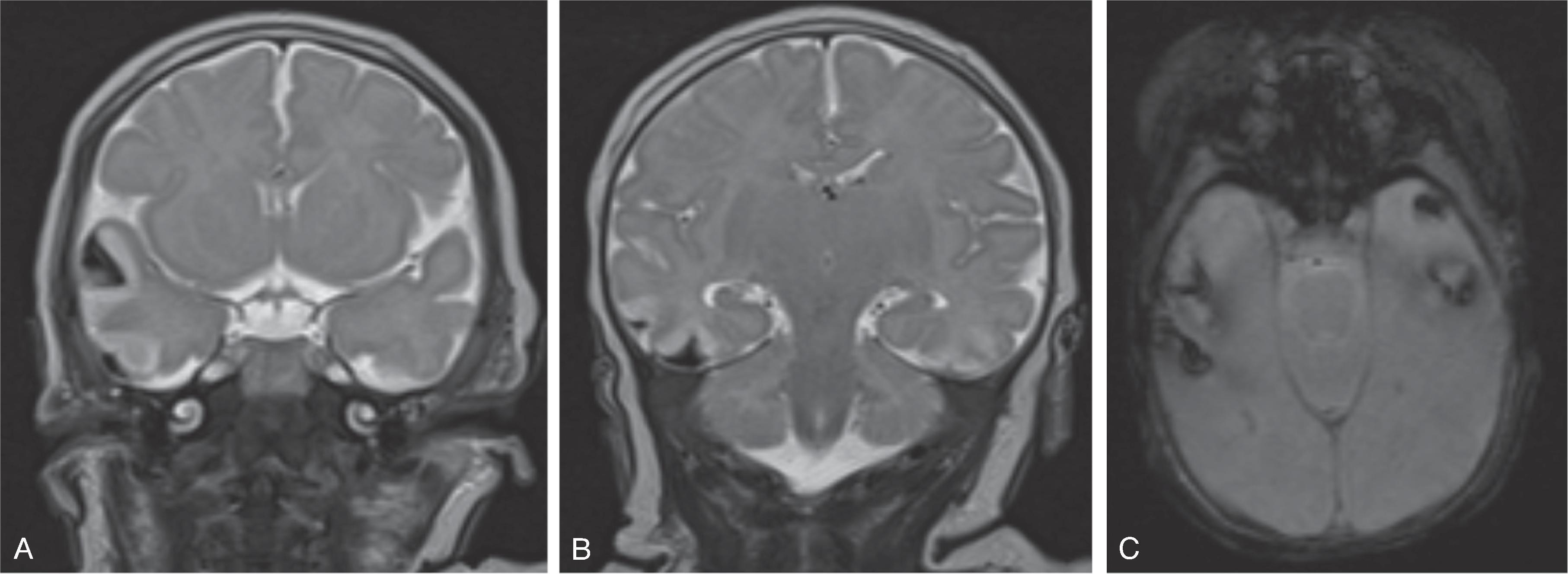
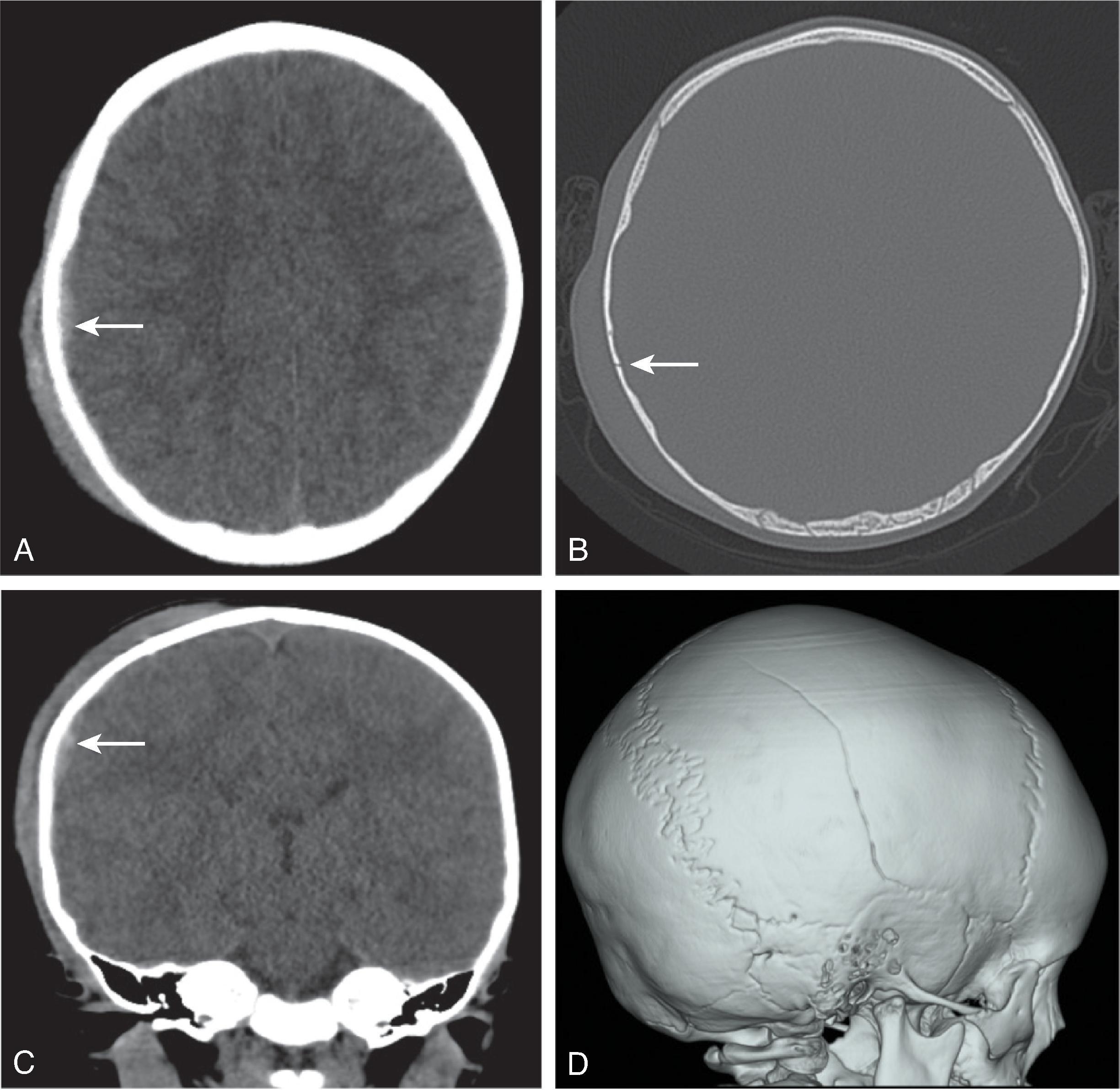
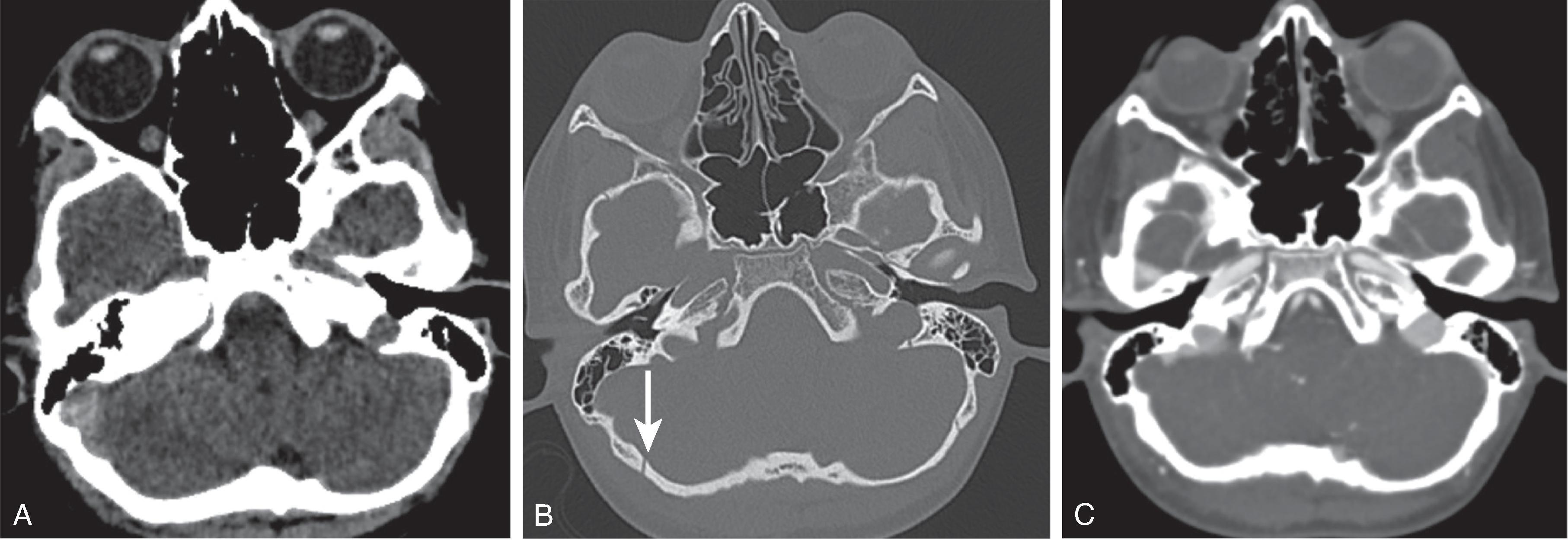
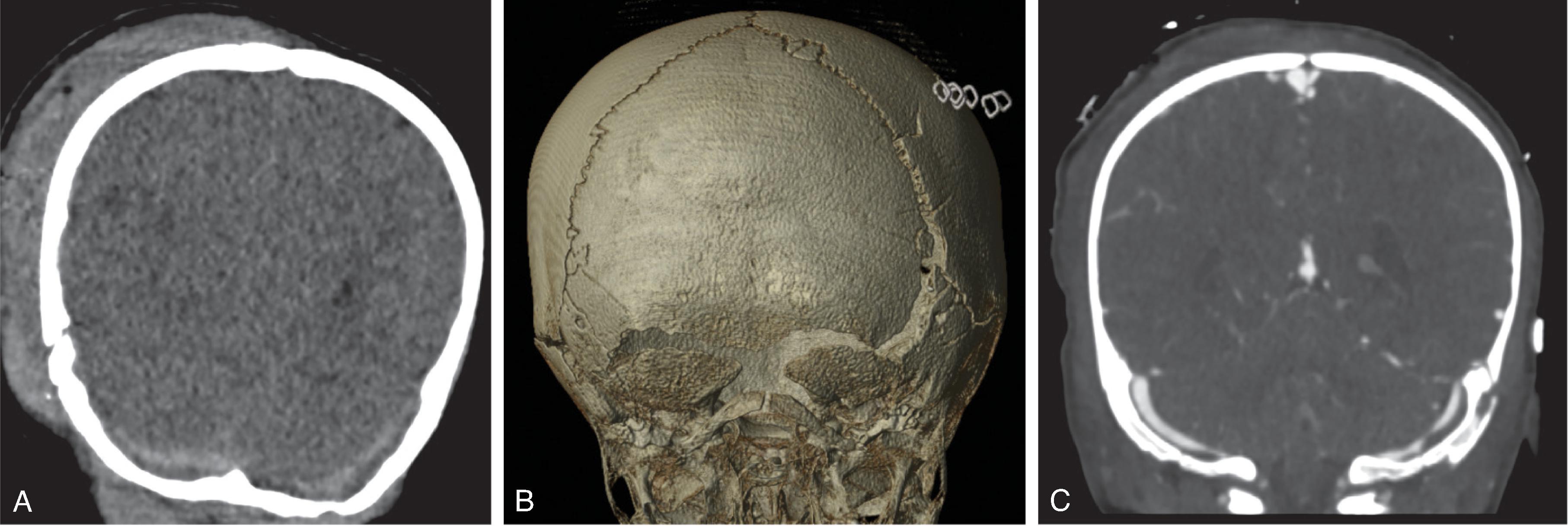
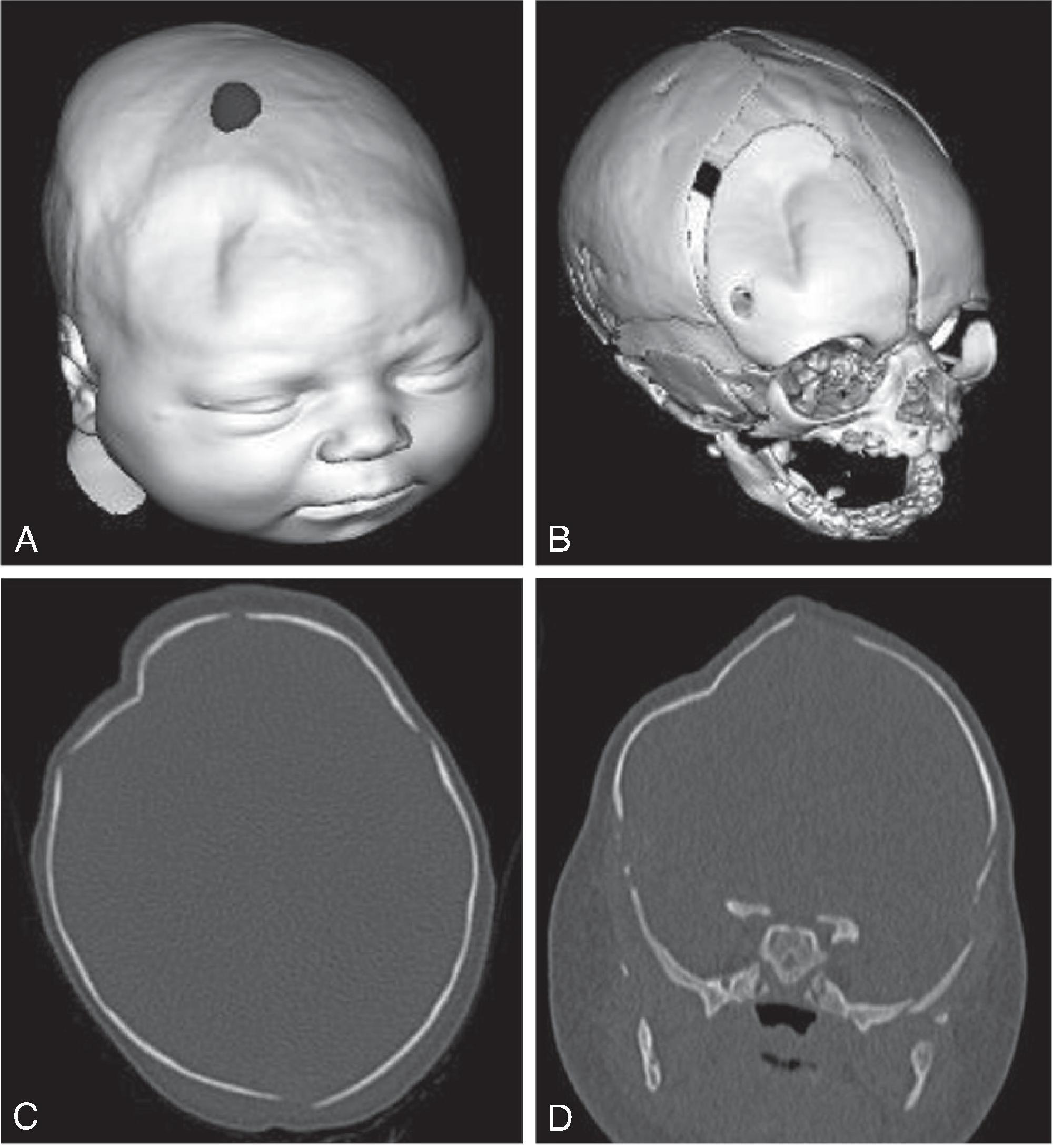


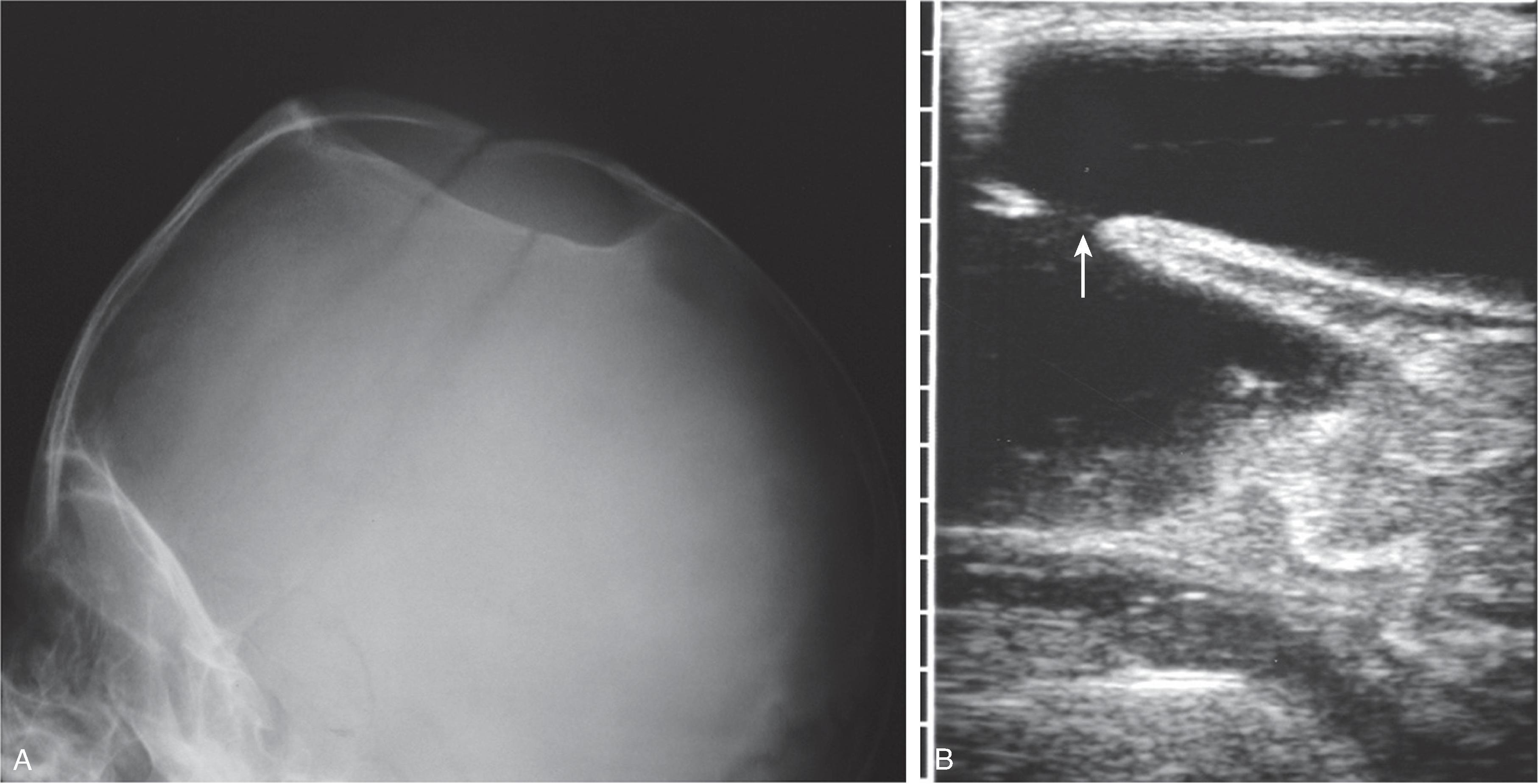
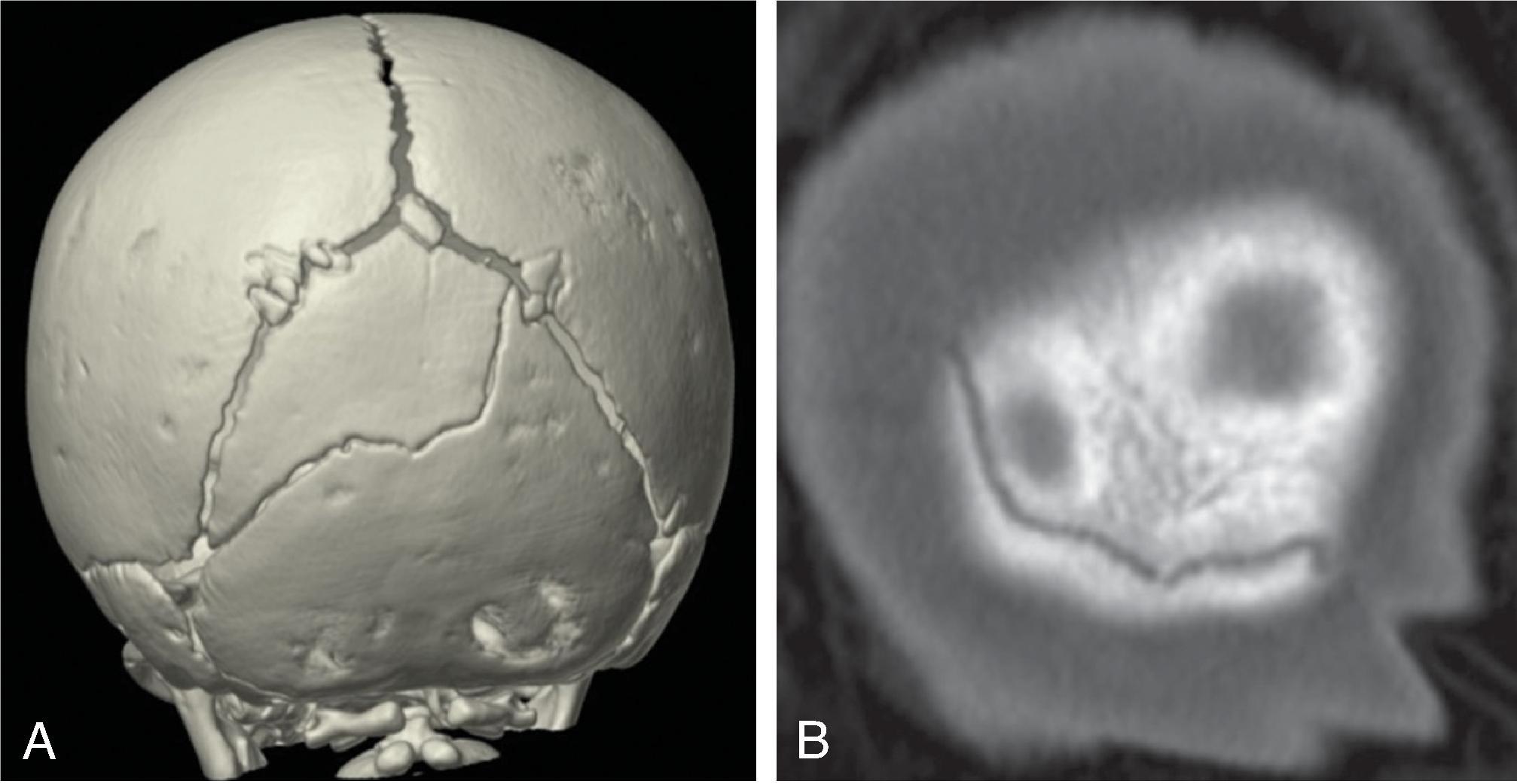
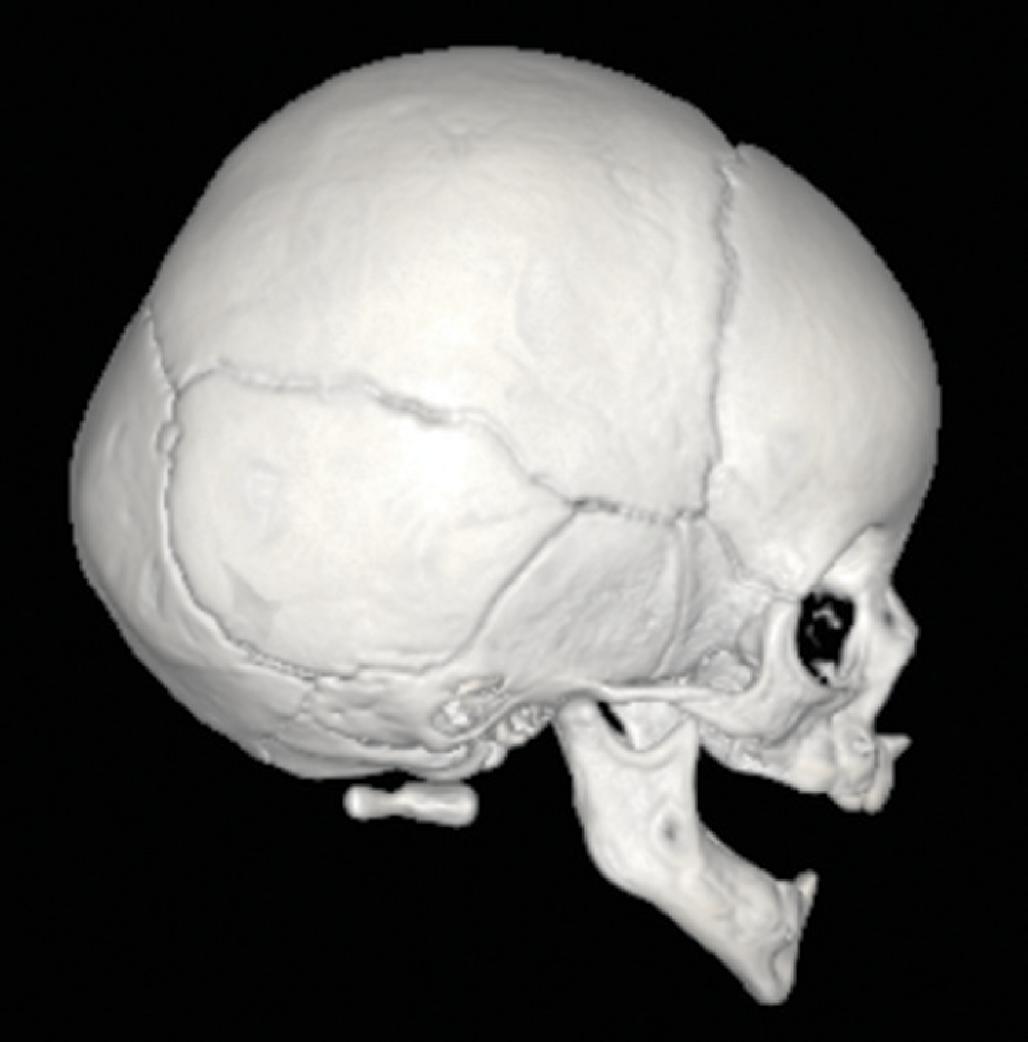
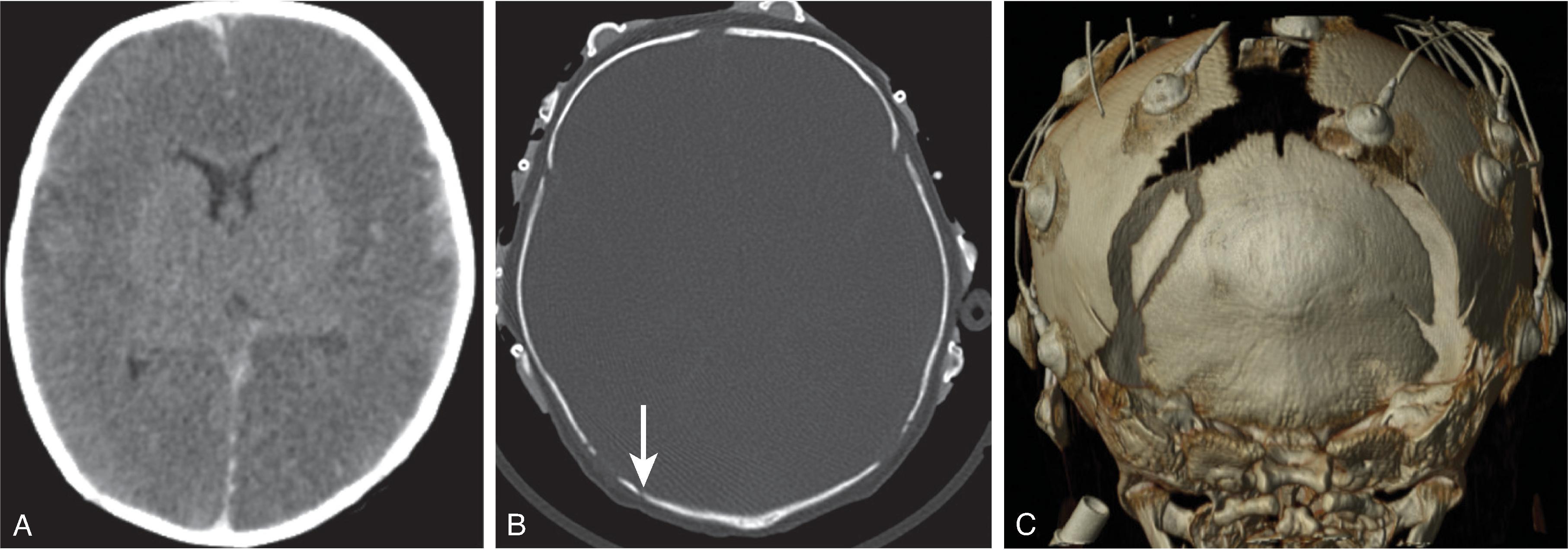
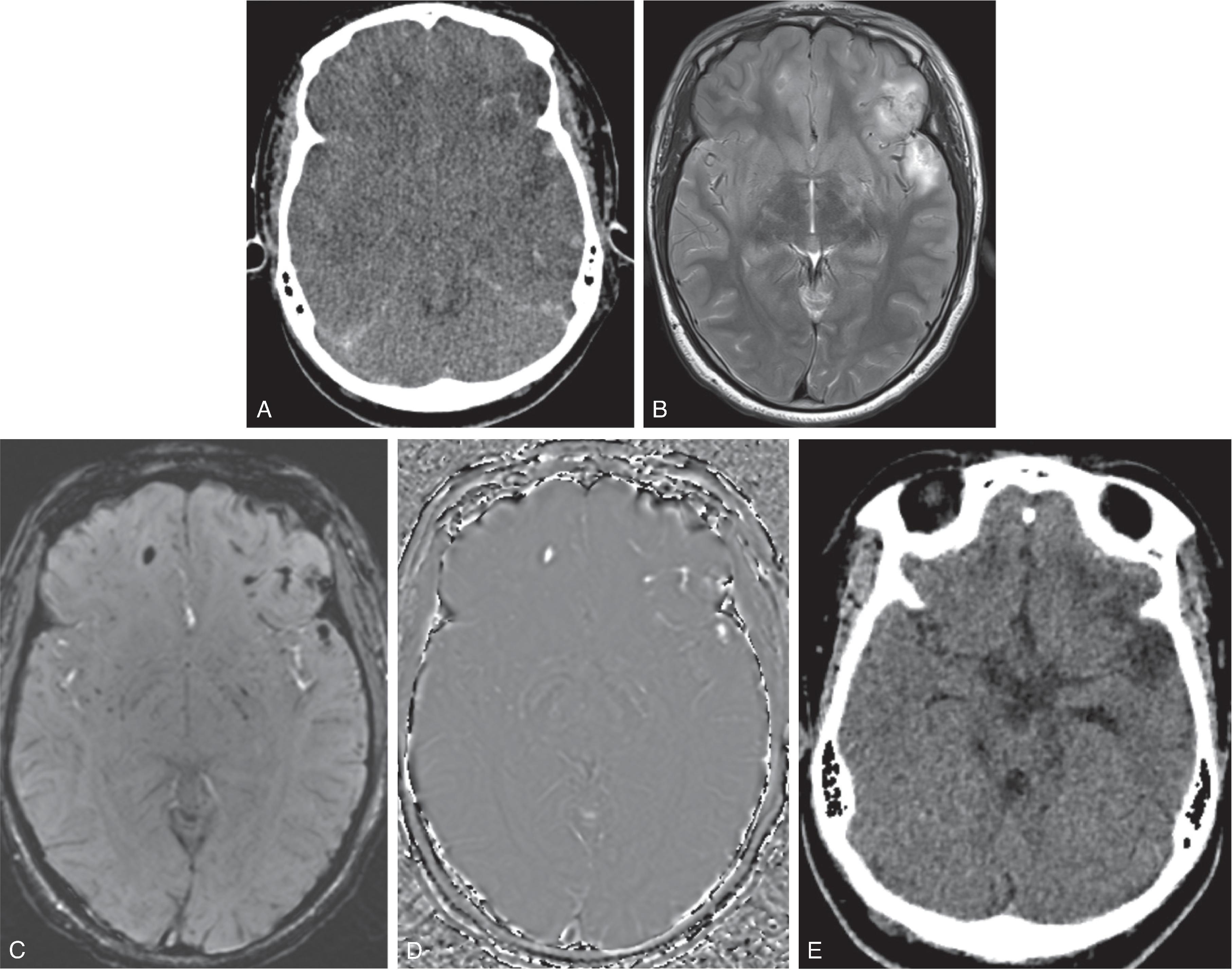
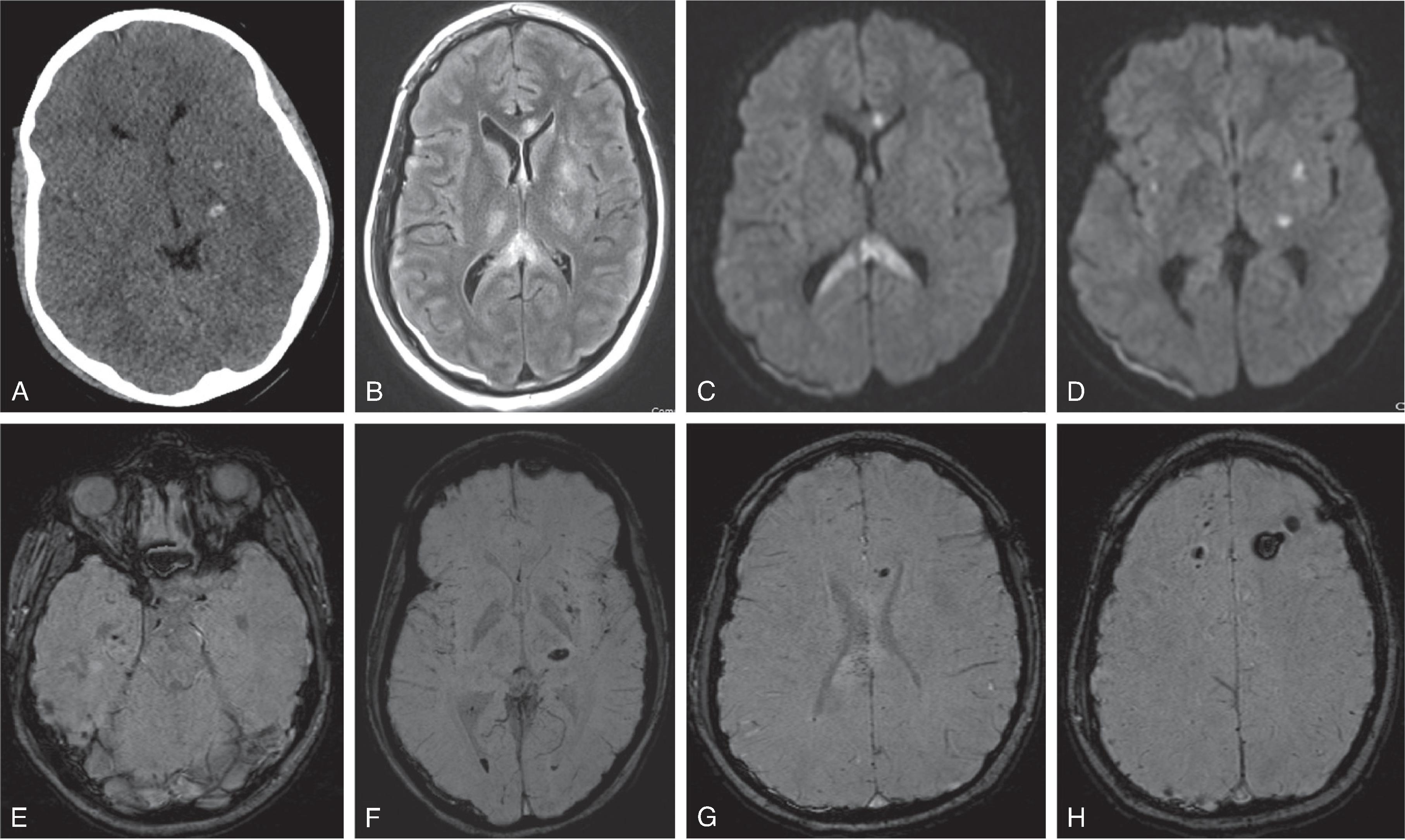

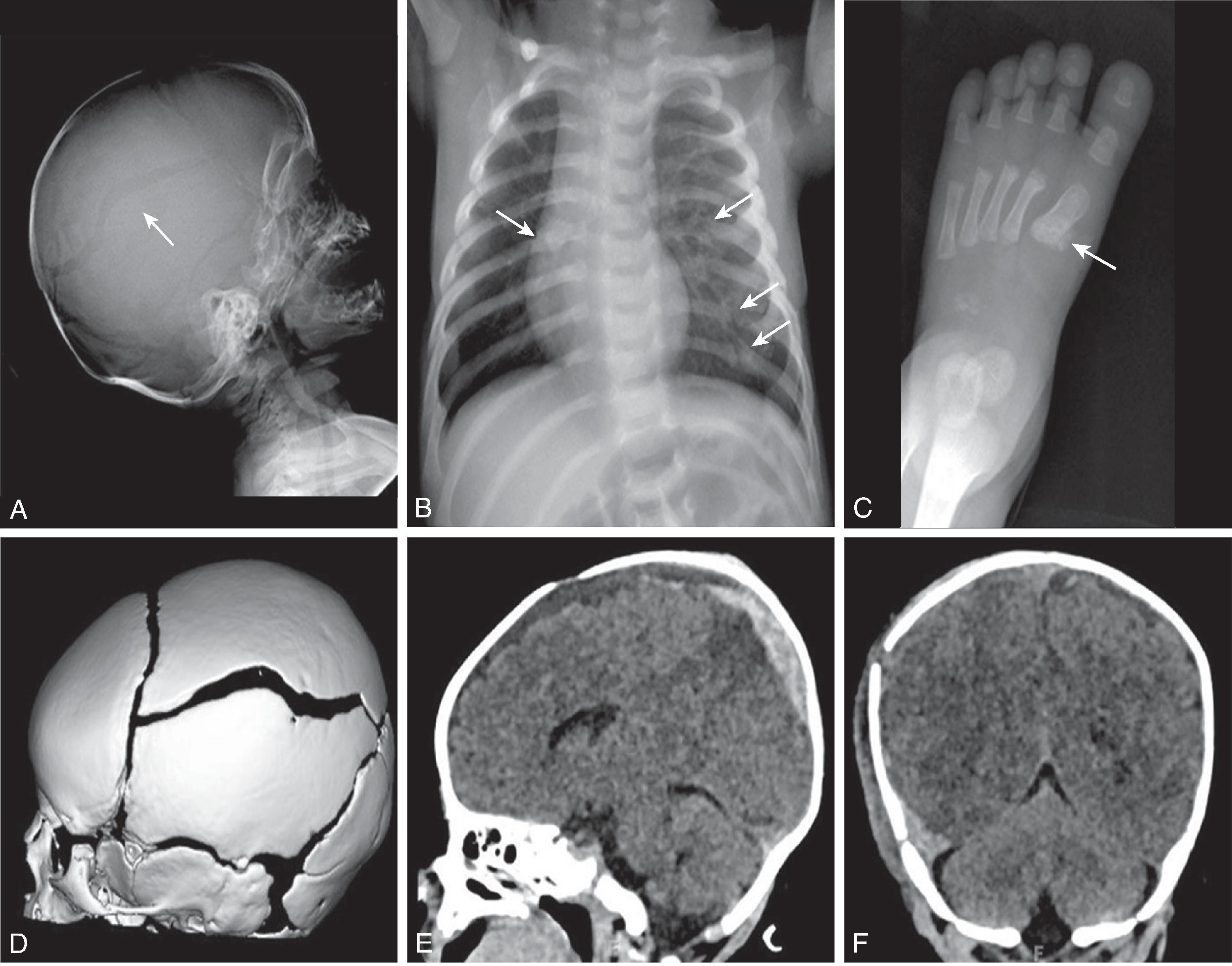
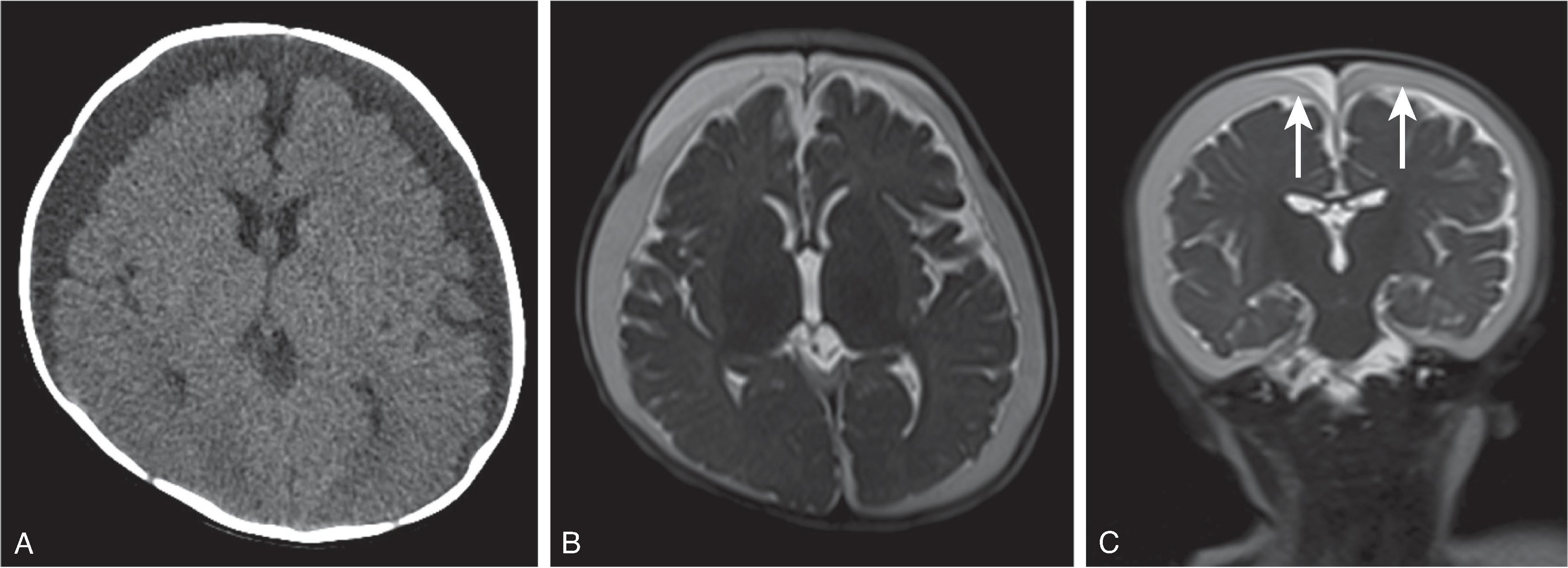

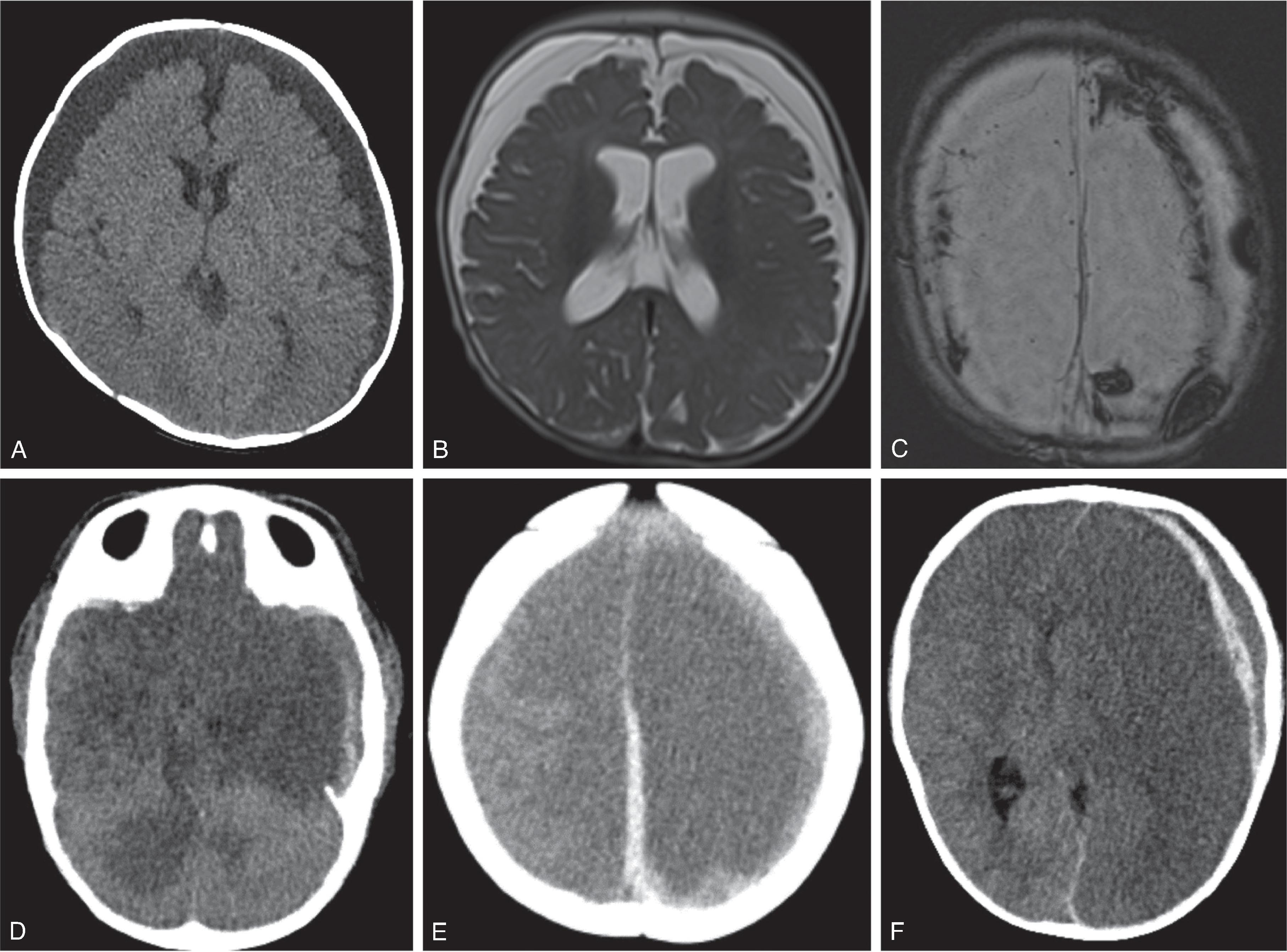
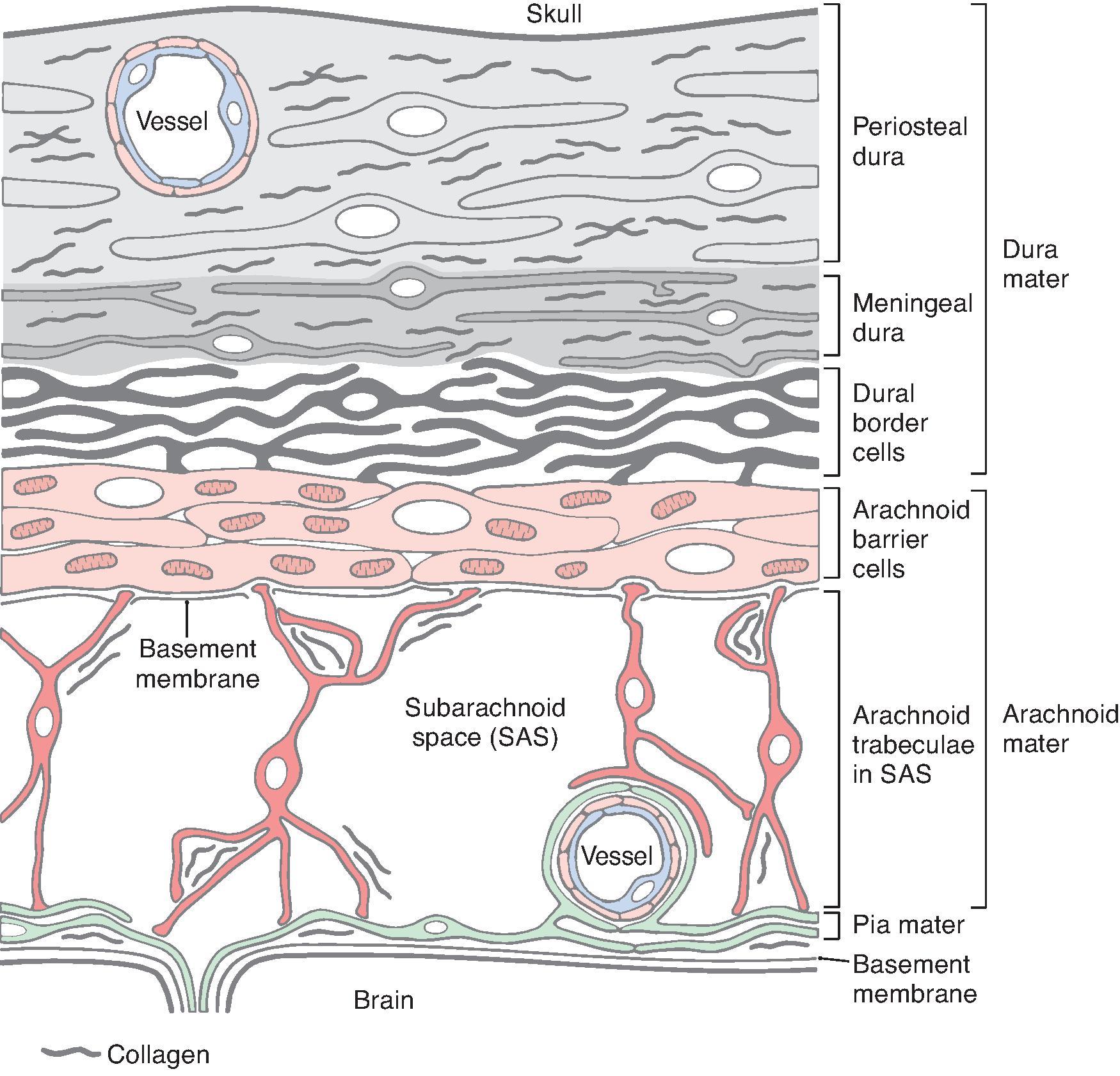
![Fig. 10.27, Simplified Schematic Drawing of the Pathogenetic Pathways of the Origin and Fate of Subdural Hygromas (SDHys). ICP , Intracranial pressure; SDH , subdural hematoma. (From Wittschieber D, Karger B, Niederstadt T, Pfeiffer H, Hahnemann ML. Subdural hygromas in abusive head trauma: pathogenesis, diagnosis, and forensic implications. Am J Neuroradiol . 2014;36[3]:432–439. https://doi.org/10.3174/ajnr.a3989 ) Fig. 10.27, Simplified Schematic Drawing of the Pathogenetic Pathways of the Origin and Fate of Subdural Hygromas (SDHys). ICP , Intracranial pressure; SDH , subdural hematoma. (From Wittschieber D, Karger B, Niederstadt T, Pfeiffer H, Hahnemann ML. Subdural hygromas in abusive head trauma: pathogenesis, diagnosis, and forensic implications. Am J Neuroradiol . 2014;36[3]:432–439. https://doi.org/10.3174/ajnr.a3989 )](https://storage.googleapis.com/dl.dentistrykey.com/clinical/BrainTrauma/26_3s20B9780323796958000102.jpg)
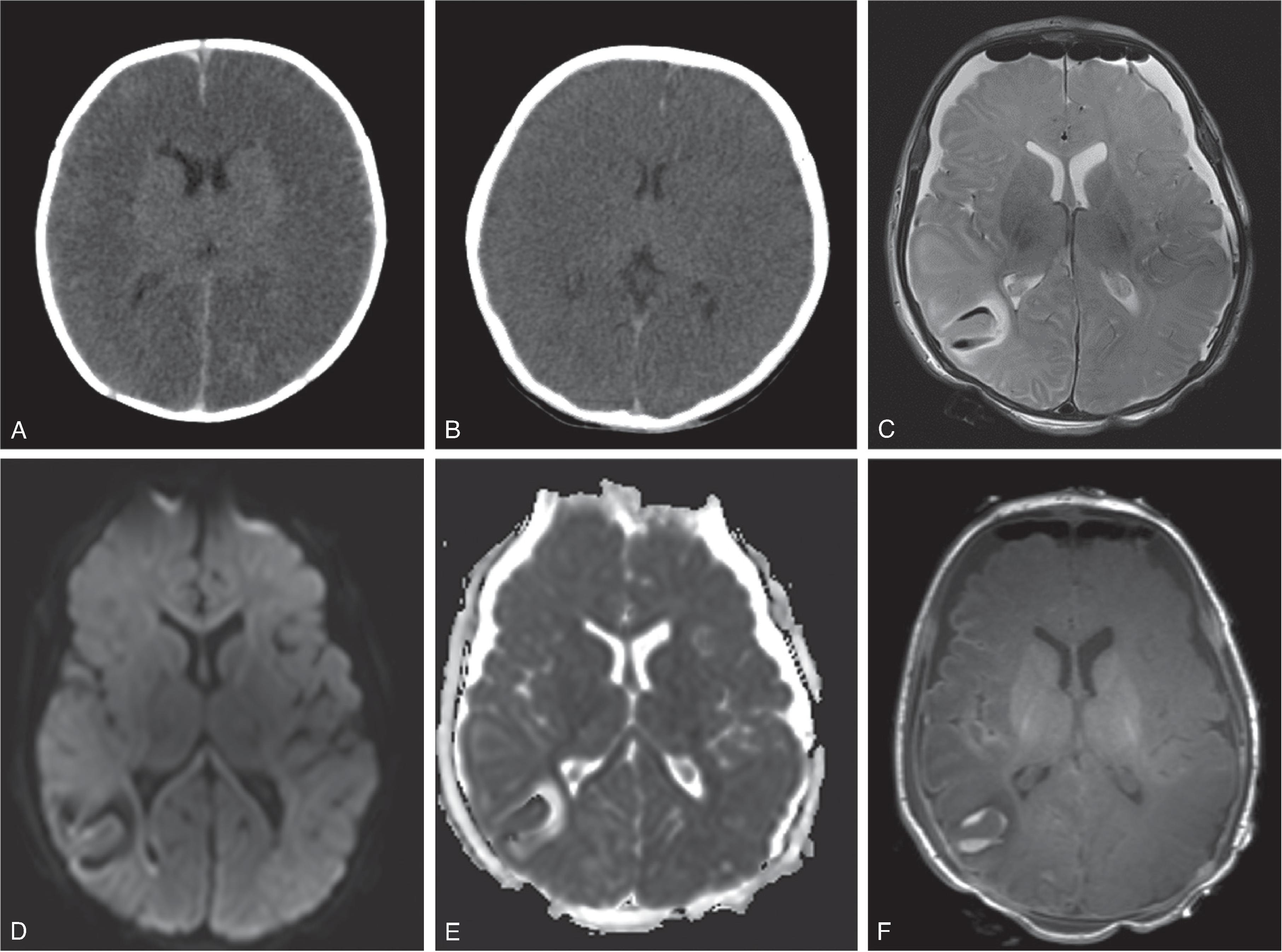
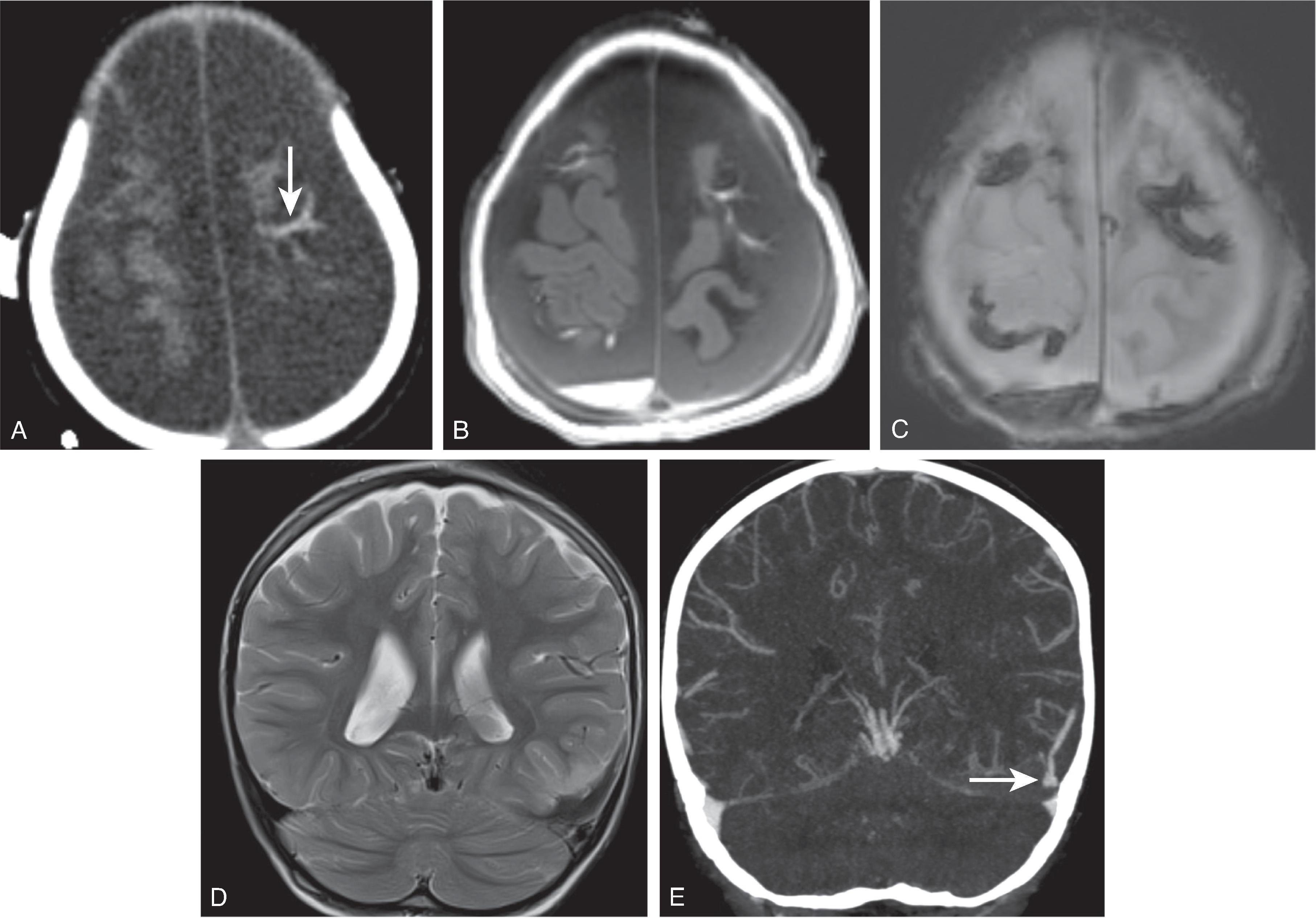


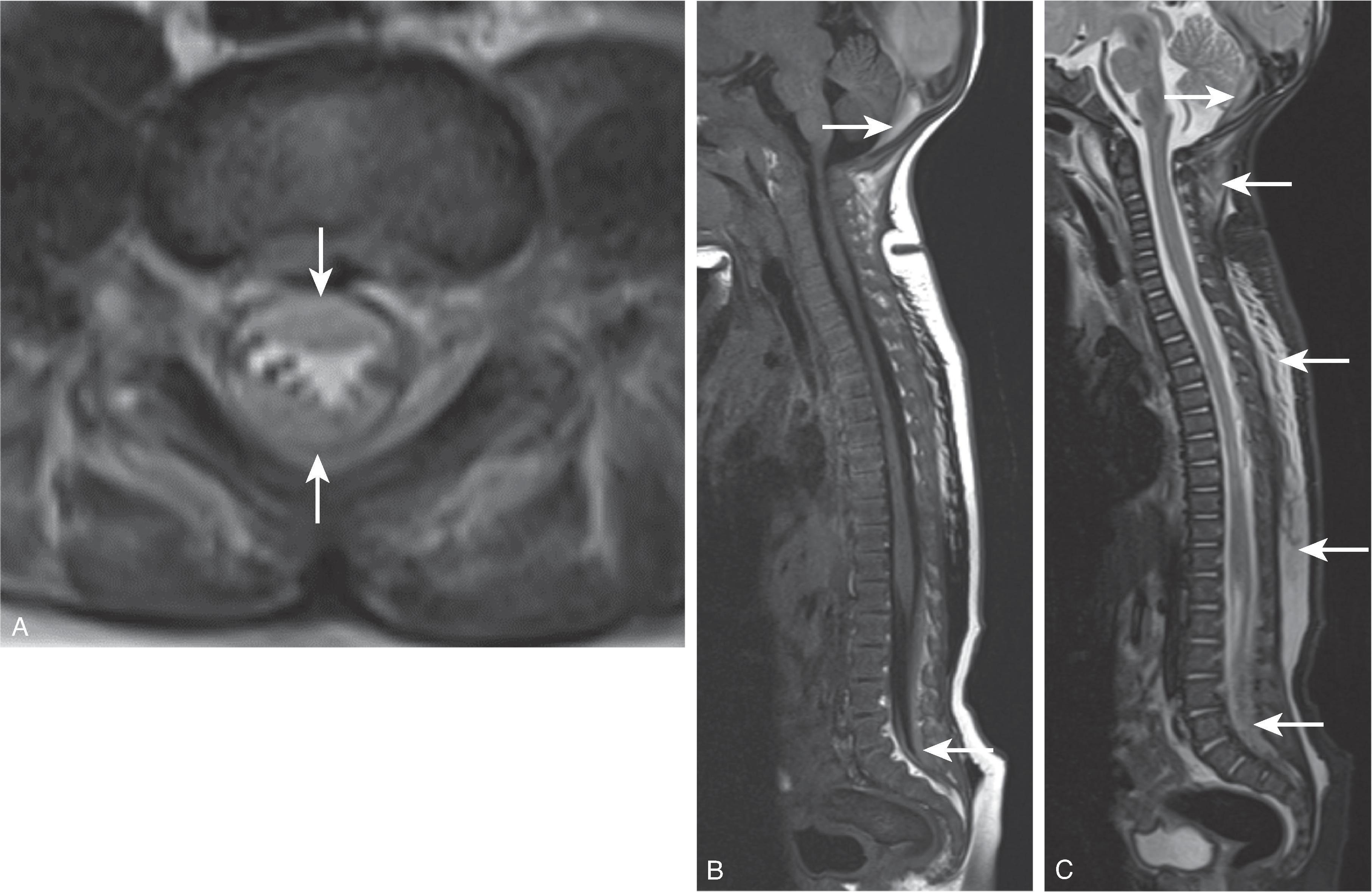
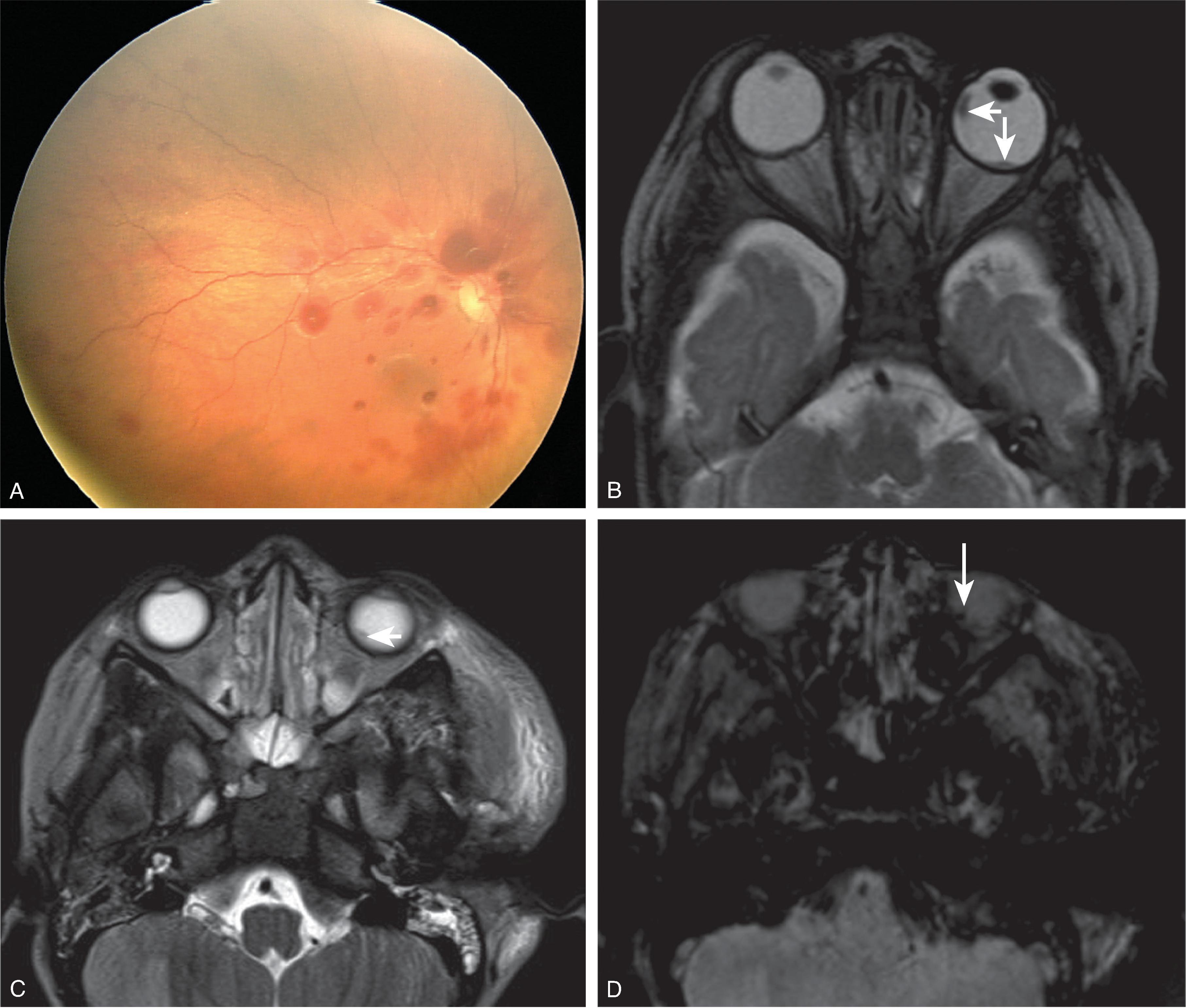
Etiology unknown; possibly birth-related trauma or venous compression, injury, or venous thrombosis
Potential explanation is that the pia mater is more easily separated from the brain in neonates than older children; therefore this may account for the relative low frequency of detection of this type of hemorrhage in older infants and children
Typical presentation is a term neonate with apnea or seizure following spontaneous vaginal delivery
Relatively uncommon but frequently occur in the temporal lobes
Limited data suggest good prognosis
At time of imaging the hemorrhage is usually T2 hypointense and T1 hyperintense and demonstrates susceptibility. The hemorrhage has a characteristic triangular shape due to the extension into the sulcus and covering of the outer cortex.
Intraparenchymal and intraventricular hemorrhage can coexist in continuity with a subpial hemorrhage.
Follow-up imaging can demonstrate encephalomalacia, gliosis, and laminar necrosis.
Head trauma findings in order of most common to least common are: scalp hematoma > scalp hematoma with skull fracture > scalp hematoma with skull fracture and epidural hemorrhage.
Skull fractures most commonly involve the parietal bone. Fractures can also be seen as suture diastasis rather than fracture lucency through the bone.
Most epidural hematomas are small but require consultation with neurosurgery for conservative versus surgical management.
Epidural hematomas are more likely from accidental rather than nonaccidental trauma.
Subdural hemorrhage can occur in accidental trauma but should raise suspicion of nonaccidental trauma in young children.
Fractures crossing a venous sinus are associated with sinus thrombosis in 20% to 40% of cases and external compression in approximately 30%.
Become a Clinical Tree membership for Full access and enjoy Unlimited articles
If you are a member. Log in here